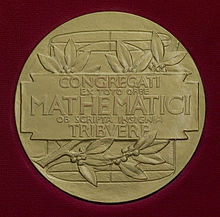| Year | Winners
|
|---|
| 1936
| Lars AhlforsFinland Finland), Harvard University Finland), Harvard University
Jesse Douglas ( United States), Massachusetts Institute of Technology United States), Massachusetts Institute of Technology
|
| 1950
| Laurent Schwartz ( France), University of Nancy France), University of Nancy
|
Atle Selberg (Atle Selberg)Norway Norway), Princeton Institute for Advanced Studies Norway), Princeton Institute for Advanced Studies
|
| 1954
| Kunihiko KodairaJapan Japan), Princeton University Japan), Princeton University
|
Jean-Pierre Serre ( France), University of Paris France), University of Paris
|
| 1958
| Klaus Friedrich Roth (United Kingdom United Kingdom), University of London United Kingdom), University of London
|
René Thom France), University of Strasbourg France), University of Strasbourg
|
| 1962
| Lars V. Hörmander (Sweden Sweden), University of Stockholm Sweden), University of Stockholm
|
John Willard Milnor ( United States), Princeton University United States), Princeton University
|
| 1966
| Michael Francis Atiyah (United Kingdom United Kingdom), University of Oxford United Kingdom), University of Oxford
|
Paul Joseph Cohen ( United States of America, Stanford University United States of America, Stanford University
|
Alexander Grothendieck ( France), University of Paris France), University of Paris
|
Stephen Smale ( United States), University of Berkeley United States), University of Berkeley
|
| 1970
| Alan BakerUnited Kingdom United Kingdom), University of Cambridge United Kingdom), University of Cambridge
|
Heisuke HironakaJapan Japan), Harvard University Japan), Harvard University
|
Sergéi Nóvikov ( Soviet Union), University of Moscow Soviet Union), University of Moscow
|
John Griggs Thompson ( United States), University of Cambridge United States), University of Cambridge
|
| 1974
| Enrico BombieriItaly Italy), University of Pisa Italy), University of Pisa
|
David Bryant MumfordUnited Kingdom United Kingdom), Harvard University United Kingdom), Harvard University
|
| 1978
| Pierre René DeligneBelgium Belgium), Institut des hautes études scientifiques Belgium), Institut des hautes études scientifiques
|
Charles Louis Fefferman ( United States), Princeton University United States), Princeton University
|
Grigori Margulis Soviet Union), University of Moscow Soviet Union), University of Moscow
|
Daniel G. Quillen ( United States), Massachusetts Institute of Technology United States), Massachusetts Institute of Technology
|
| 1982
| Alain Connes (Alain Connes) France), Institut des hautes études scientifiques France), Institut des hautes études scientifiques
|
William P. Thurston ( United States), Princeton University United States), Princeton University
|
Shing-Tung Yau United States, Princeton Institute for Advanced Studies United States, Princeton Institute for Advanced Studies
|
| 1986
| Simon Donaldson (United Kingdom United Kingdom), University of Oxford United Kingdom), University of Oxford
|
Gerd FaltingsGermany Germany), Princeton University Germany), Princeton University
|
Michael Freedman ( United States), University of San Diego United States), University of San Diego
|
| 1990
| Vladimir Drinfeld ( Soviet Union), Institute of Physics of Kharkov Soviet Union), Institute of Physics of Kharkov
|
Vaughan Jones (New Zealand New Zealand), University of Berkeley New Zealand), University of Berkeley
|
Shigefumi MoriJapan Japan), Kyoto University Japan), Kyoto University
|
Edward Witten ( United States, Princeton Institute for Advanced Studies United States, Princeton Institute for Advanced Studies
|
| 1994
| Pierre-Louis Lions France), Université de Paris-Dauphine France), Université de Paris-Dauphine
|
Jean-Christophe Yoccoz France), Université de Paris-Sud France), Université de Paris-Sud
|
Jean BourgainBelgium Belgium), Princeton Institute for Advanced Studies Belgium), Princeton Institute for Advanced Studies
|
Yefim ZelmánovRussia Russia), University of Wisconsin Russia), University of Wisconsin
|
| 1998
| Richard Ewen Borcherds South Africa), University of Cambridge South Africa), University of Cambridge
|
W. Timothy Gowers (United Kingdom United Kingdom), University of Cambridge United Kingdom), University of Cambridge
|
Maxim KontsevichRussia Russia), Institut des hautes études scientifiques Russia), Institut des hautes études scientifiques
|
Curtis T. McMullen United States), Harvard University United States), Harvard University
|
| 2002
| Vladimir VoevodskyRussia Russia), Princeton Institute for Advanced Studies Russia), Princeton Institute for Advanced Studies
|
Laurent Lafforgue France), Institut des hautes études scientifiques France), Institut des hautes études scientifiques
|
| 2006
| Andrei OkounkovRussia Russia), Princeton University Russia), Princeton University
|
Grigori Perelmán (Russia Russia), Steklov Mathematical Institute (rejected the award) Russia), Steklov Mathematical Institute (rejected the award)
|
Terence Tao Australia), University of California, Los Angeles Australia), University of California, Los Angeles
|
Wendelin Werner France), Université de Paris-Sud France), Université de Paris-Sud
|
| 2010
| Elon LindenstraussIsrael Israel), Hebrew University of Jerusalem Israel), Hebrew University of Jerusalem
|
Ngô B emblemo Châu (Vietnam Vietnam and Vietnam and  France), Paris-Sud 11 University and Institute for Advanced Study France), Paris-Sud 11 University and Institute for Advanced Study
|
Stanislav SmirnovRussia Russia), University of Geneva Russia), University of Geneva
|
Cédric Villani France), Henri Poincaré Institute France), Henri Poincaré Institute
|
| 2014
| Artur ÁvilaBrazil Brazil and Brazil and  France), National Institute of Pure and Applied Mathematics France), National Institute of Pure and Applied Mathematics
|
Manjul Bhargava (Canada Canada and Canada and  United States), Princeton University United States), Princeton University
|
Martin HairerAustria Austria), Imperial College London Austria), Imperial College London
|
Maryam MirzajaniIran Iran), Stanford University Iran), Stanford University
|
| 2018
| Caucher BirkarIran Iran and United Kingdom Iran and United Kingdom United Kingdom), University of Cambridge United Kingdom), University of Cambridge
|
Alessio Figalli (Alessio Figalli)Italy Italy), Federal Polytechnic School of Zurich Italy), Federal Polytechnic School of Zurich
|
Peter Scholze (Germany Germany), University of Bonn Germany), University of Bonn
|
Akshay Venkatesh Australia), Stanford University Australia), Stanford University
|
| 2022
| Hugo Duminil-Copin ( France), Institut des hautes études scientifiques France), Institut des hautes études scientifiques
|
June Huh (South Korea South Korea), Princeton University South Korea), Princeton University
|
James Maynard (United Kingdom United Kingdom), University of Oxford United Kingdom), University of Oxford
|
Maryna ViazovskaUkraine Ukraine), Federal Polytechnic School of Lausanne Ukraine), Federal Polytechnic School of Lausanne
|
